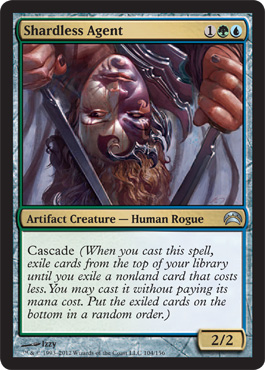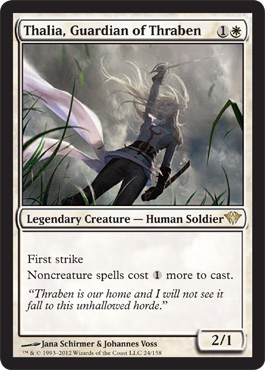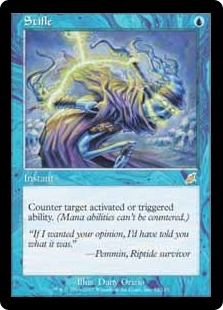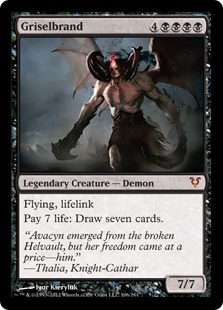Are you a Quiet Speculation member?
If not, now is a perfect time to join up! Our powerful tools, breaking-news analysis, and exclusive Discord channel will make sure you stay up to date and ahead of the curve.

With SCG Columbus in the books, it looks like Hypergensis is the hot new technology. In the Gerry Thompson/Kaitlin Lindburg decktech it was cited that the deck gained a lot from Shardless Agent, as it allowed the deck to have a workable manabase where it didn’t really have one before.
I would like to address why this doesn’t actually have any relevant impact on Legacy.
If you’re not the type of person that is interested in wasting time on the particulars of why things are the way they are, then I’m going to save you a bit of time and tell you the conclusion of this article:
Hypergenesis is just a worse version of Sneak and Show.
Now that I’ve gotten rid of those guys, let’s get down to the nitty-gritty of the situation.
Last week Adam Barnello wrote an article about various Legacy decks that he loves and why they are bad. Among this analysis he cited Cephalid Breakfast as being a worse version of Dredge. In his breakdown, Barnello observed that Breakfast loses to everything that Dredge loses to and a whole lot more.
Sneak and Show and Hypergenesis have a similar dynamic.
Very Similar Game Plans
First, let’s dispel any illusions that anybody might have about these decks being very different in the first place. Both are just trying to cheat in some outrageous fatty which they are both capable of doing on turn one. Both accomplish this by resolving a non-creature spell. Both back this plan up with countermagic.
While the decks are quite similar in their overarching plan, where they differ is in the actual execution of this plan. It’s not just enough to say that these things are different, though. At every place where the two decks differ, Hypergenesis is actually just doing something worse.
The Manabase
For starters, Sneak and Show plays a few more lands than Hypergenesis. Some of Sneak and Show’s lands even tap for two mana. This difference can be huge in a world of Dazes and Spell Pierces.
This is also relevant when you consider Hypergenesis’ fast mana in the form of Spirit Guides. Sometimes the deck will have to rely on casting a Cascade spell or a Show and Tell off of this type of fast mana effect and will be unable to generate three mana again for some time if its efforts are countered.
I would consider it a red flag when it feels like getting to three mana is actually a part of my combo.
The Early Game
If you tried to analyze the Hypergenesis deck for any level of play, you wouldn’t come up with very many different lines for a particular game.
It is, in essence, a Belcher deck. You’re at the mercy of the spells that you draw and you have zero way to manipulate this. The only thing you can really do is play draw-go until the last possible turn before you would die to see if you can draw the fatty, counterspell or blue spell to pitch to your counterspell that you need to go off.
Sneak and Show, on the other hand, has access to the best library manipulation in the format in the form of Brainstorm and another fine draw spell in the form of Ponder. Hypergensis simply cannot play these cards as they would be miserable to Cascade into.
I don’t think that I’d have to think very hard about playing a deck that has to raw-dog its combo versus playing a deck with the most powerful draw spell in the format.
The Counter Suite
This is where things get really miserable for Hypergenesis.
Every counterspell that they play is a pitch spell. This means that even if the Hypergenesis player is able to play three lands and cast a Cascade spell or Show and Tell, the most counters they could possibly back it with is three. This is only possible if they started the turn with all three of these mana sources in play, drew their eighth card at the start of their turn, three of their pitch spells, three more blue cards to pitch to them and a fatty to boot. More generally, the deck is lucky to have even double counter backup.
Alternatively, Sneak and Show has access to Spell Pierce maindeck and Red Elemental Blast out of its sideboard. Having one-for-ones in a counterwar is, quite literally, twice as good as only having Force of Wills. These are cards that Hypergenesis simply cannot play as, again, they muck up Cascading.
Hypergensis (the card) vs. Sneak Attack
While both decks feature four copies of Show and Tell, Hypergenesis has twice as many Cascade spells as Sneak and Show has Sneak Attacks. This sounds pretty good at first, but this isn’t strictly an advantage to Hypergenesis.
There is a very real possibility, however slim, that the Hypergenesis player draws both copies of its namesake sorcery. This functionally turns off eight other slots in the deck while stranding you with at least those two dead cards in hand.
The number of times you can go off with Hypergenesis in your deck is 2 - (the number of Hypergenesis you've drawn) - (the number of Hypergenesis that have already been countered). The number of times you can cast Sneak Attack is most commonly four.
Sneak and Show is not only better at not drawing redundant spells because of Ponder, but it can actually get rid of extra Sneak Attacks with Brainstorm.
This particular comparison might not necessarily leave Hypergenesis disadvantaged, but taken in the bigger picture and reiterating the cantrip point makes it pretty clear which of these decks I’d rather be playing.
Of course, all of these disadvantages would be fine if there was something about Hypergenesis that made it better in the larger context of the metagame, but the deck fails this test as well.
Thalia

Maverick hasn’t been hugely present lately, but Thalia, Guardian of Thraben is still a very real card. Is she insane against Hypergenesis or what?
Sure, the deck can go off on turn one sometimes or it has until turn two to beat a Thalia deck on the play, but how does it ever actually beat this card? Thalia requires you to spend four on your Cascade spell only to spend another one on your actual Hypergenesis. With your sixteen land deck. Good. Luck.
This explains the necessity of having the four Dismember on the sideboard, but, again, your only play is to naturally draw one in your combo deck with zero library manipulation.
This is not to say that Thalia isn’t a problem for Sneak and Show. I’ve definitely seen Maverick savage that matchup from time to time, but at least Sneak and Show has more play to try and work itself out of tight situations.
Stifle

I’m still pretty confident in saying that RUG Delver is the best deck in Legacy, and anytime you see me playing Legacy you can bet that I’m playing this deck with the full four Stifle.
Stifle can range from worthless to phenomenal in the Sneak and Show matchup. Sometimes they just play basics into a City of Traitors into a Show and Tell and you don’t even have a Force of Will to pitch it to. Others you can stop them from ever developing the manabase to have a chance in the counterwar.
Against Hypergenesis, Stifle is essentially a hard-counter against Violent Outburst and the 2/2 body on Shardless Agent is hardly relevant. It also has the potential to really punish Hypergenesis’ very light manabase.
Show and Tell Mirrors
Have you ever noticed how bad Show and Tell gets when your opponent is doing things that are just as busted as the things that you're doing?
Guess which deck can board out its Show and Tells.
In games two and three, the Sneak and Show player is going to be much better at countering the Hypergenesis player (if their hand even dictates that they care about your Show and Tell) and actually has a non-symmetrical win condition.
All these things considered, I would never think of playing Hypergenesis in Legacy. The only real benefit is that it’s a lot easier to play than Sneak and Show due to the deck’s complete lack of flexibility.
I don’t like to be the bad guy who rails on people for doing cool things, but somebody has to step in when those cool things are done just for the sake of being cool. If you want to play with Griselbrand then play to win with him. Play Sneak and Show.
Speaking of Griselbrand…
STOP CYRING FOR BANS OF THIS MAN!

“Hypergenesis is just another busted Griselbrand deck.”
“Sneak and Show is only viable because of Griselbrand.”
“Blah blah walking Necropotence blah blah.”
Just cut it out. Hypergenesis is only “viable” now because of the addition of Shardless Agent. Griselbrand was hardly the major change there.
More importantly - how much does it actually matter what your opponent cheats in with Show and Tell?
Think about your opponent resolving a Show and Tell when you’re not playing a big cheaty monster deck. How often are you winning from this position anyway? If you’re a deck with Karakas, Swords to Plowshares and Knight of the Reliquarys, then you would probably rather face a Griselbrand than a Progenitus to be entirely honest.
Granted, Griselbrand gives them the ability to draw into more action, but with all of the deck’s monsters being legendary and each activation of Griselbrand costing seven life, I can’t imagine Sneak and Show has a lot of time to set up between the first activation and the turn that the Knight kills them.
I know that when I’m playing RUG I have to treat every Show and Tell, Sneak Attack and Hypergenesis exactly the same, and the reason is not that I’m afraid of Griselbrand. I’m losing to any fat-fat-fatty-boom-baladdy that they cheat in and that’s that.
I’m not saying that Griselbrand isn’t the total monster that he is. Clearly the card adds some number of wins to Show and Tell decks that they wouldn’t have without him. But the difference isn’t as dramatic as people make it out to be.
~
When it comes to picking up and modifying Legacy decks, a working knowledge of decks that are currently played and have been played historically is invaluable. It’s pretty rare that something completely new happens in Legacy, and the ability to identify which decks a particular list is similar to can allow a player to make considerably better judgment calls than players lacking such sight.
Trying new things is great, but it’s not something that’s inherently good. Sometimes you end up with a busted Survival of the Fittest engine and others you end up with a worse version of something somebody else has already tried.
Innovate with caution.
-Ryan Overturf






I loved this article. Keep up the good work!
You may want to copyright the phrase " fat-fat-fatty-boom-baladdy " before I slap it on a t-shirt.
Patent pending.
nice article duder! you have a affinity for writing it seems +3
Well positioned on how you explain the differences between the decks. As far as being worse, yes I absolutely agree with your points.
As a counter point – there is room for a "strictly worse" version of a deck when you are referring to a player's budget. As more and more players are attempting to get involved in Legacy, this small fact (looking past the "best deck" being most important) supplants other reasons to play superior decks.
Sometimes budget just overrides all.
Damn I'm glad I'm gainfully employed and have the money to play whatever I want *grin*
Fair point. Though I don't know that Hypergenesis is necessarily a budget deck. TCG Player has its average price listed around $1,250. Cheaper than some decks for sure, but not terribly far off their average price of Sneak and Show at $1,427 (Anderson's and Hickerson's lists respectively). Both decks play three duals with the major difference is the inclusion of "sol" lands in Sneak and Show, which have been pretty consistently playable in Legacy, though I can see why one wouldn't want to pick them up.
Personally I don't have the budget to build anything I want, but I have some really good friends who do.